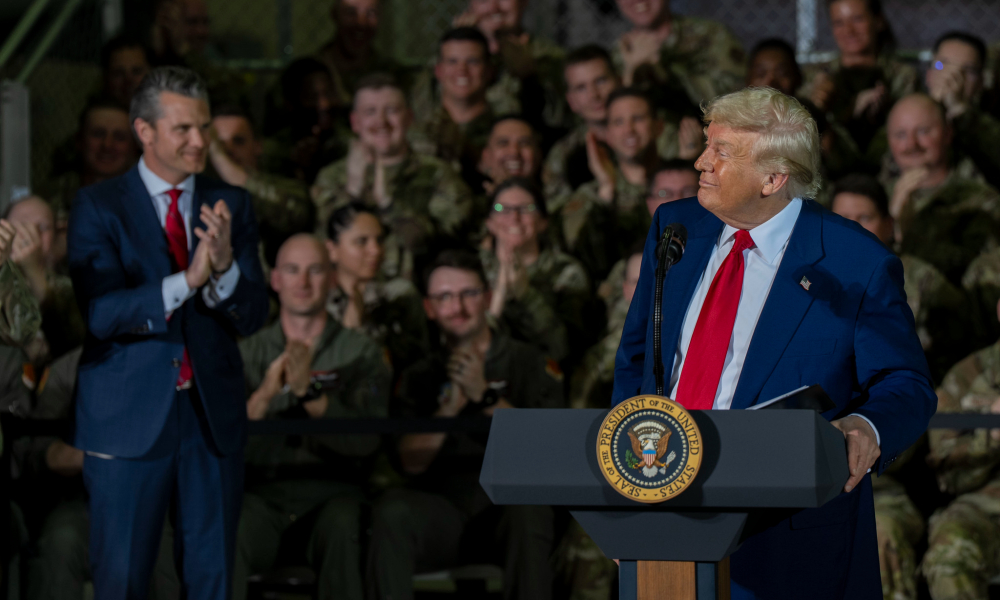Trump’s Misguided War on Transgender Troops

Published by The Lawfare Institute
in Cooperation With

Editor’s Note: The Trump administration has moved quickly to ban transgender people from serving in the U.S. military. The George Washington University’s Alexander Downes reviews the justifications the administration has cited—the cost to unit cohesion, the medical cost to the military, and the dishonorable nature of transgender people in general—and finds all of them wanting, making a strong case that transgender people should be welcome in the U.S. armed forces.
Daniel Byman
***
It didn’t take long for the Trump administration’s war on transgender troops to get underway. One week after his inauguration, President Trump issued an executive order misleadingly titled “Prioritizing Military Excellence and Readiness.” The order—which was initially blocked by two federal judges but reinstated in early May by the Supreme Court—asserts that “expressing a false ‘gender identity’ divergent from an individual’s sex cannot satisfy the rigorous standards necessary for military service.” Under the new policy, transgender soldiers with any diagnosis, history, or symptoms of gender dysphoria will be discharged.
Trump’s order offers three reasons why transgender people should be excluded from military service. It posits, first, that transgender soldiers undermine unit cohesion, which is argued to be an essential ingredient of military effectiveness; second, that transgender people are incapable of meeting the military’s rigorous standards and adversely affect readiness; and third, that transgender soldiers lack the honor and truthfulness needed to serve because they are living a lie.
The problem is that each of these claims is false, as I noted when these issues arose when Trump first came into office. Transgender troops have served honorably with no adverse effect on cohesion or readiness for years. The order to remove them from the military is not based on any evidence to the contrary and is thus without foundation.
To be the object of such a sweeping order, one might think that transgender people make up a large proportion of the U.S. military. That is incorrect. Of the 2 million Americans who serve on active duty or in the National Guard and reserves, an estimated 15,500—less than eight-tenths of 1 percent—are transgender. This figure is slightly higher than the percentage of trans people in the U.S. population (0.5 percent) but lower than the proportion of trans people of prime military age (1.3 percent). The Pentagon recently gave an even lower figure of 4,240 trans soldiers—or two-tenths of 1 percent—which includes only those formally diagnosed with gender dysphoria.
On the face of it, therefore, the claim that transgender troops constitute a threat to “the pursuit of military excellence” is a stretch. Why, then, does the administration want so badly to get rid of them?
The Threat to Military Cohesion
Trump’s order claims that the “Armed Forces have been afflicted with radical gender ideology” that has permitted transgender people to serve but has had a detrimental effect on unit cohesion.
The objection that diversity erodes unit cohesion has been raised against every marginalized American group—African Americans, women, and gays—that has sought to serve its country.
For example, Army Chief of Staff Gen. George Marshall argued prior to World War II that allowing Black soldiers into white units would undermine morale and military efficiency. More recently, a member of the joint chiefs of staff testified in 1993 that allowing gays to serve openly would “paralyze a unit, and degrade unit cohesion and erode combat effectiveness.”
Study after study, however, has found no evidence that diversity reduces military cohesion or effectiveness. For example, Marshall’s contention that integrating Black troops into white units would sabotage unit cohesion was belied by postwar surveys. An overwhelming majority of white officers and noncommissioned officers (NCOs) said that white and Black soldiers had gotten along “fairly” or “very well.” Not a single one reported that troops of different races had gotten on poorly.
The likely reason for these positive relations was that whites perceived Black soldiers to be good fighters. When asked in the same survey how well Black soldiers had performed in combat, every officer and 98 percent of NCOs said fairly or very well. When asked to compare Black and white troops as infantry soldiers, similarly high proportions of both groups rated Black soldiers as the same as, or better than, white soldiers.
The integration of openly gay soldiers since the end of the “don’t ask, don’t tell” (DADT) policy in 2011 was similarly a non-issue. The effect is perhaps best summed up in the words of the Marine commandant at the time, Gen. James Amos. He told reporters shortly after the policy took effect that it was a “non-event” and acknowledged that his previous opposition to the change was “misplaced.”
Across the military, a survey undertaken by combatant commanders a year after DADT ended found “no impact” on “military readiness, effectiveness, unit cohesion, and recruiting and retention.” Chairman of the Joint Chiefs of Staff Gen. Martin Dempsey summarized the report in January 2013 by saying that ending DADT had had “no impact.” In this regard, the experience of the U.S. military replicates that of the militaries of other major countries, including Australia, Canada, Germany, Israel, Italy, the Netherlands, and Great Britain—where allowing gays to serve openly was found in a RAND study to have no impact on cohesion, performance, or recruitment and retention.
Finally, although evidence is limited, what we do know about trans soldiers suggests that their service has had no effect on cohesion in the U.S. (or any other) military. Indeed, all four service chiefs testified before the Senate Armed Services Subcommittee on Personnel in 2018 that “open transgender service has had no negative effect on unit cohesion, discipline, or morale.” This assessment tracks with the experiences of trans and non-trans soldiers alike; as one trans Navy officer with 20 years of service noted, “They’ve tried to make a big deal out of this, just like they did in the past with integrating women or African Americans, but it’s just a nothing-burger. I’ve had fifteen trans soldiers in my command over the years and never had an issue. The other sailors treat them like anyone else. All they want to know is, Will you show up and do your job?”
Why is there so little evidence that diversity weakens unit cohesion or performance? The reason—as the case of Black soldiers in World War II suggests—is that the kind of cohesion that matters is not so much whether soldiers are friends (social cohesion) but whether they can work together to achieve shared goals (task cohesion). And diversity has little bearing on task cohesion, which modern studies have shown is based on rigorous training and shared professionalism, commitment to a shared goal, and pride in accomplishing those goals.
What about the second part of the claim—that unit cohesion is essential to military effectiveness? With the caveat that the type of cohesion that matters is task cohesion, which is not impaired by diversity, the answer is that although it does improve performance in small units, it is far from the most important contributor to overall battlefield effectiveness.
Cohesion by itself—without trained soldiers, proper tactics, combined arms capability, and good strategy—is of little value. Iranian volunteers in the Basij and Pasdaran militias during the Iran-Iraq War, for example, were highly cohesive but—like their World War I predecessors—ineffective because they launched frontal assaults across open terrain against massed firepower.
The best available studies have found many contributors to battlefield performance—among them high levels of tactical and operational skill, unifying ideologies, government regime types, command structure, and logistical capacity. Notably, an important recent study of 250 wars over two centuries found that ethnically homogeneous and heterogeneous armies were equally effective—as long as the minority groups in the latter were not targeted for discrimination or repression.
In other words, it is discrimination, not inclusion, that undermines military power. The claim that purging the armed forces of highly qualified, patriotic—but different—people is essential to military excellence has no basis in fact.
Medical and Readiness Costs
The second reason the Trump order gives for excluding trans soldiers from the military is that “expressing a false ‘gender identity’ divergent from an individual’s sex cannot satisfy the rigorous standards necessary for military service.” Beyond a vague reference to “hormonal and surgical medical interventions,” no evidence is given to support the view that trans soldiers are not fit to serve. There is, however, much evidence that contradicts this claim.
Existing studies, for example, find no evidence that transgender soldiers are less physically or mentally healthy than non-trans troops. One such study reported that its results “did not support the notion of poor mental or physical health as primary grounds for excluding or discharging transgender people from active-duty service.” A second study noted that “the sample as a whole reported above average physical health, with mood symptoms within normal ranges and few reported risk behaviors.”
Furthermore, the cost in terms of medical treatments and readiness of transgender troops is dwarfed by the costs of getting rid of them—and ignores the benefits of including them. When Trump initially moved to exclude transgender soldiers during his first administration, estimates already existed of the costs of transgender-related medical care in the U.S. military. One 2015 study in the New England Journal of Medicine put such costs at $5.6 million per year (which roughly matches the figure of $52 million over 10 years recently released by the Pentagon), whereas a RAND report from 2016 produced a most likely estimate of $2.4-3.4 million. The latter range constituted about five-thousandths of 1 percent of the $6.3 billion active-duty health care costs. Actual costs may be even lower; recent research from the Congressional Research Service found that the Department of Defense spent a total of $15 million on gender-affirming care for fewer than 2,000 personnel from January 2016 to May 2021, or less than $3 million per year.
The 2016 RAND study also found that the effect of trans-related medical treatments on troop availability for deployment would be miniscule, based on the commonsense argument that very, very few soldiers receive treatments (such as surgeries) that would make them unavailable to deploy. Many need only a single hormone shot once a week.
What about the costs of separating transgender troops from the military? Commander Emily Schilling, one of the plaintiffs in the lawsuit challenging Trump’s executive order, stated that the Navy spent $20 million on her training as a combat aviator. More broadly, the Palm Center at San Francisco State University estimated in 2017 that expelling the roughly 13,000 transgender military personnel at that time would cost $960 million. In other words, the U.S. government would spend nearly $1 billion to save a few million dollars on transgender health care. What is impossible to estimate is the cost of lost expertise, knowledge, experience, and diverse viewpoints at a time when the military struggles to meet its recruitment goals.
Honor, Truth, and Discipline
The final, and most scurrilous, reason the Trump executive order gives for excluding trans soldiers is the claim that transgender people attempting to serve their country are essentially dishonorable and dishonest: “adoption of a gender identity inconsistent with an individual’s sex conflicts with a soldier’s commitment to an honorable, truthful, and disciplined lifestyle.” “A man’s assertion that he is a woman,” the order continues, “and his requirement that others honor this falsehood, is not consistent with the humility and selflessness required of a service member.”
No evidence is offered in support of these claims, which evince a fundamental misunderstanding of what it means to be transgender and, as Judge Ana Reyes put it in her ruling blocking the order, are “soaked in animus.” Indeed, the government conceded in court that the “assertions” made about transgender people in the executive order “are pure conjecture” with no data to back them up. The government similarly conceded that the service members who brought suit against the new policy were “mentally and physically fit,” met rigorous standards, “served honorably,” and “made America safer.” Banning transgender people from the military may, in fact, create problems where none previously existed by forcing them to hide their true selves to continue serving.
In short, there is no hue and cry within the military to expel transgender troops for the simple reason that they serve with honor and distinction. Moreover, estimates suggest that transgender people are twice as likely as non-transgender people to serve in the military, and they want to continue to serve even as they have come under assault from the new administration. The evidence is clear that they should be able to do so.




